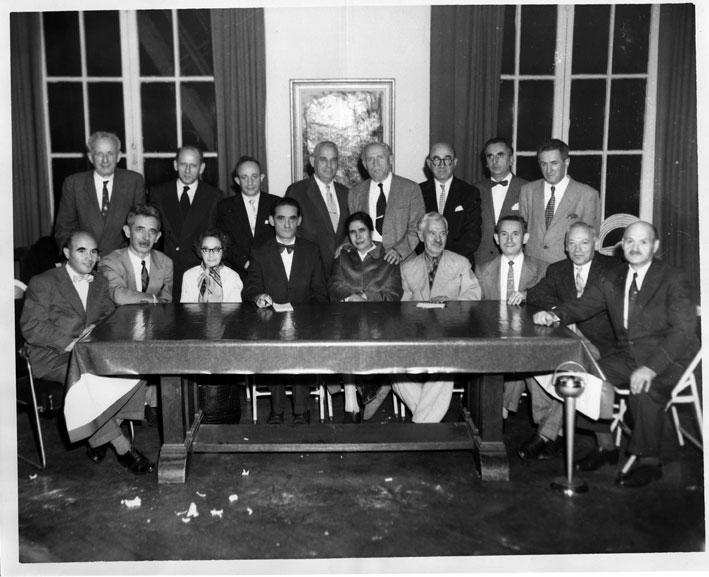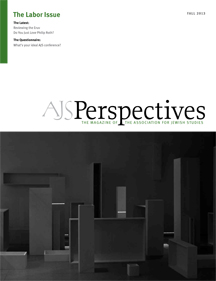
While the Bund’s pre-Holocaust history is well documented, particularly its early years in czarist Russia and its transformation in independent Poland, we know less about the fate of the Bund after the demise of Polish Jewry during the Holocaust. Historians have generally assumed that the Bund perished in the ruins of the Warsaw Ghetto. The reality is more complex.
Although it would never again reach the popularity and influence it had enjoyed among Jews in interwar Poland, Bundist life continued late into the twentieth century and beyond. In postwar Poland, where the ruling communist Polish United Workers’ Party forced the Bund to liquidate at the beginning of 1949, it never stood a chance. However, Bundists established branches in dozens of cities around the world and tried to rebuild some semblance of what had been destroyed. Bundists also came together in Brussels in 1947 to form the International Jewish Labor Bund, an organizing body based in New York that incorporated Bund groups and organizations from dozens of locations. Like all Holocaust survivors, the process of rebuilding their lives was disorienting for Bundists, but the structures they created gave them a sense of comfort and familiarity that helped them navigate the process of displacement. Yet how could a movement so rooted in the conditions and circumstances of prewar eastern Europe adapt to new circumstances in which surviving Polish Jews were now only a tiny proportion of world Jewry, scattered in pockets throughout Western Europe, the Americas, Israel, and Australia?
***
The trajectory of the Bund after the Holocaust—its successes and contradictions—can be seen in the lives of two men who would come to lead their respective chapters of the Bund. These two men lived contrasting lives. They experienced both the Holocaust and the process of resettlement differently, yet in their attempts to rebuild the Bund in different settings, Emanuel Scherer and Bono Wiener highlight two different aspects of the postwar Bund’s fortunes: the local and the global.
Emanuel Scherer was the Bund’s leading intellectual in the postwar years. A lawyer by trade, his presence looms large in the visual and documentary record of the movement’s American branch and the World Coordinating Committee. His lanky frame, bushy eyebrows, bow tie, and stern expression exemplified the earnestness with which the Bundists approached the task of carrying the Bund’s legacy into the post-Holocaust world. One Bundist who worked alongside Scherer in the early 1970s told me that Scherer didn’t dance. “Dancing is for the bourgeoisie,” Scherer would say. “I’ll dance when the revolution comes.”
Scherer and many other Bundists like him were not ready to give up the dream of revolution, of socialism in their lifetime, and of Jews fostering Yiddish cultural life in democratic and multiethnic societies. He was preoccupied with the Bund’s relevance on the global Jewish stage in the wake of the Polish Jewry’s decimation and of the Polish Bund’s liquidation. How could it continue to maintain its prewar significance in the new world order of a Jewish state and the rapid decline of Jewish socialism?
Like Scherer, Melbourne Bund leader Bono Wiener is ever present in the records of his local Bund chapter, both physically and spiritually. Standing over six-feet tall, with a knowing smile (which later was often beaming through his greying moustache), Wiener was an energetic activist, a tuer in Yiddish, in the truest sense of the word. Reared in the Bundist children’s movement and Yiddish schools in Lodz, he led the Bundist youth in the Lodz ghetto underground, survived Auschwitz, and tried to rebuild the Bund in Lodz immediately after the war. When he eventually settled in Melbourne in 1951, he very quickly became a prominent figure within the Melbourne Bund, the local Jewish community, and among the migrant chapter of the Australian Labor Party. In contrast to Scherer, Wiener’s work was mainly focused on issues of local significance. Rather than ruminating on what role the party might play globally, Wiener focused on the Bund’s role in its local context and how it could help to shape a changing Jewish community in Melbourne.
The two men are studies in contrast: Scherer was born and raised in Austro-Hungarian Krakow; Wiener, in interwar Lodz. Scherer escaped Europe at the beginning of the war and spent those years in New York and London trying to bring the Jews’ plight to the attention of the world. Wiener led the Bundist youth underground in the Lodz ghetto and was sent to Auschwitz after the ghetto’s liquidation. Scherer spent the remainder of his life employed by the Bund; Wiener was a laborer-turned-businessman, whose political activities supplemented his working life. Scherer was known for his intensity; Wiener, for his good humor, malleability, and fondness for a bottle of whisky. Scherer maintained his fervent anti-Zionism throughout his life. Wiener, on the other hand, held strong affection for the State of Israel, visiting regularly and making financial contributions.
While Scherer clung to ideas about the future prospects for socialism and operated primarily in the political and theoretical sphere, Wiener was more concerned with the day-to-day concerns of how to best improve the lot of the Australian working class, and how to secure the place of Yiddish culture among Australian Jewry. Certainly, he dreamed of the triumph of democratic socialism, but he was very much consumed by how this would play out locally. This contrast is at the heart of the postwar Bund, which was torn between its desire to recreate a glorious, imagined past, and the realities on the ground in which it no longer carried widespread appeal. With the decline of the organized Jewish labor movement everywhere except Israel and the marginalization of Yiddish in Jewish life, Bundists stood little chance of reinventing their shattered movement.
***
The Bund in the postwar world operated on two interconnected levels: the global and the local. It is the latter in which the postwar Bundist story is most important. Bundists set up a transnational network that sought to ensure the movement’s continuing relevance in global Jewish discourse. Within that network, Bundists debated how to approach the challenges facing both Jews and socialists on the world stage. The Cold War formed a difficult backdrop. Scherer usually had the first and last word in those debates. He represented the Bund at every meeting of the Socialist International until his death in 1977, and maintained relationships with leadings socialists around the world. The transnational network supported the local activities of larger and smaller Bundist communities.
The true significance of the postwar Bund can be seen in how it helped shape local Jewish life in Melbourne, Paris, Buenos Aires, Mexico City, Montreal, and other similar locales. It was in these small- and medium-sized communities with sizeable Polish-Jewish populations that the Bundists were able to exert influence and rebuild some modicum of the Bundist life that had been crushed in by Nazism and Stalinism. Bundists set up cultural institutions: youth movements, Yiddish supplementary schools, and libraries. They participated, sometimes in a meaningful way, in their local labor movements and socialist parties. In Melbourne, Bono Wiener initiated the short-lived New Australians Council, a branch of the Australian Labor Party that supported and represented migrants, and recruited them into the Labor Party. Such organizations served an important purpose for the several thousand Bundist migrants who sought a sense of familiarity and community.
But the story of the postwar Bund is ultimately one of decline. The deterioration of Yiddish and socialism and the rise of the State of Israel perhaps made this inevitable. After the Holocaust, the Bund could at best hope to be a kind of “third way” in Jewish life, an alternative to the major ideological and cultural forces. As Scherer would proclaim, on the major questions facing Jews during the Cold War, the Bund could be no more than a party of “naysayers” in a world where Zionism and communism were the dominant political ideologies among Jews.
When looking deeper at Bundists such as Bono Wiener, it becomes clear that the Bund still played a substantial role in local Jewish communities. The movement was particularly important in the lives of its few thousand followers, still dedicated to the Yiddish socialism in which they were reared, that was all but destroyed in the fire that engulfed European Jewry.

